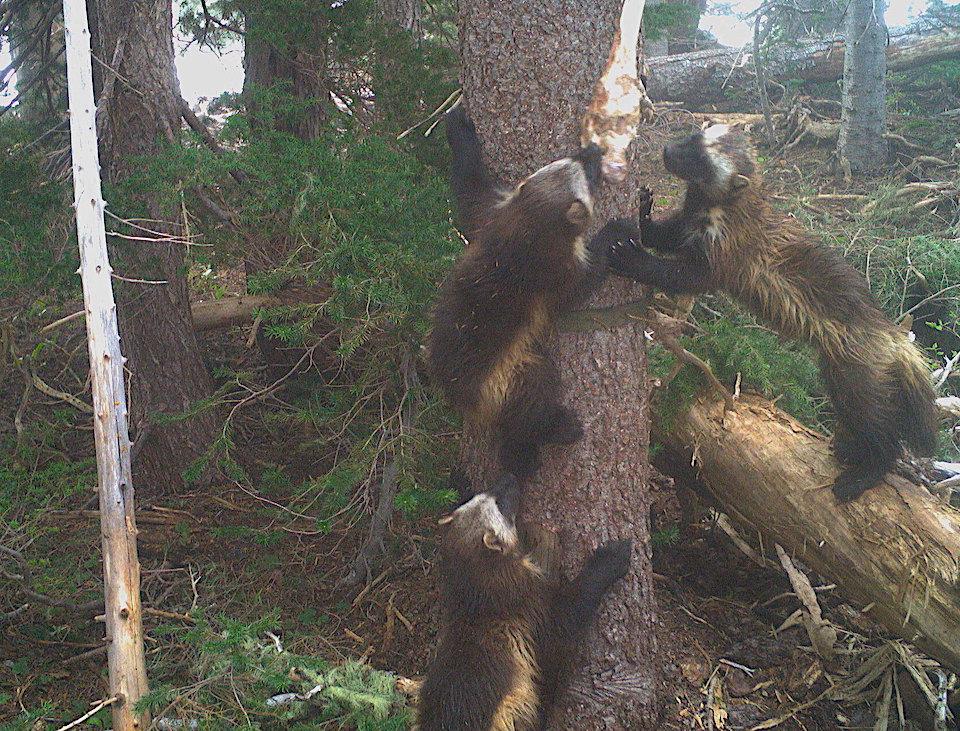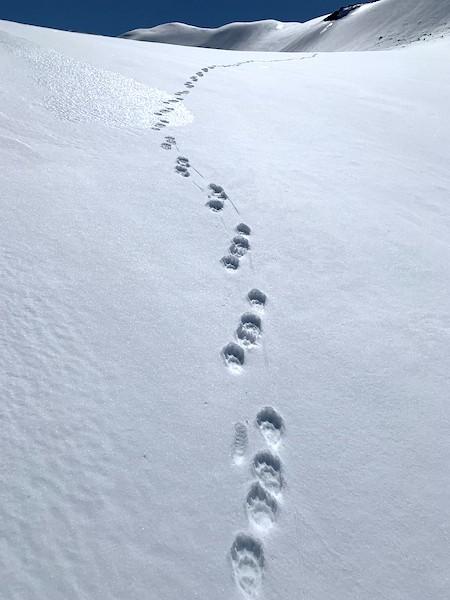
A wolverine and her two kits have been photographed in Mount Rainier National Park/Cascades Carnivore Project
For the first time in more than a century a female wolverine and her two kits have been confirmed to be roaming Mount Rainier National Park.
Another wolverine, a male, also has been spotted in the park recently, but the discovery of the female with kits was hailed as evidence that the park once again can be a breeding ground for the species.
“It’s really, really exciting,” said Mount Rainier Superintendent Chip Jenkins. “It tells us something about the condition of the park — that when we have such large-ranging carnivores present on the landscape that we’re doing a good job of managing our wilderness.”
Wolverines are extremely rare in the United States. In North America, population estimates range from 6.2 wolverines per 600 square miles in high-quality habitat to 0.3 per 600 square miles in low-quality habitat. There are estimated to be only 300-1,000 individual wolverines in the lower 48 states, a park release said.
Dr. Jocelyn Akin, who leads the Cascades Carnivore Project, said the appearance of wolverines in the national park can be used as a barometer of sorts to measure climate change impacts.

Wolverine tracks at Mount Rainier National Park/Cascades Carnivore Project
“Many species that live at high elevation in the Pacific Northwest, such as the wolverine, are of particular conservation concern due to their unique evolutionary histories and their sensitivity to climate change,” Akins said. “They serve as indicators of future changes that will eventually affect more tolerant species and, as such, make good models for conservation in a changing world.”
Images of the female and her offspring were captured by remotely triggered cameras set up in Mount Rainier in 2018 after wolverines were detected in areas adjacent to the park. The male also showed up recently in a photo from one of the park's camera traps.
Through photos, scientists can identify individual wolverines based on their distinct chest blazes.
"We set up one camera station in 2018 following Dr. Akins' discovery of the den outside of the park, and now have six camera stations in remote areas of the park," Dr. Tara Chestnut, Mount Rainier's wildlife ecologist, said Friday in an email. "We are conducting genetic tests on hairs we collected at the camera stations to identify the individuals and family lineages. This will provide information about the genetic diversity and dispersal of the individuals in Washington’s South Cascades, if they or their parents also visited camera stations with hair snares in other study areas in Washington, British Columbia, Idaho, or Montana."
Chestnut said the female is just the "second known wolverine breeding to occur in Washington south of I-90 in modern times. We detected one wolverine through analysis of scats that were found in the park and were able to confirm it was 'Pepper,' the female Dr. Akins discovered denning just outside of the park two years ago."
Akins' documentation in 2018 of a wolverine den site in Washington’s South Cascades was the first in the region since the carnivores were extirpated in the 1930s.
"Also in 2018, a dispersing male wolverine was struck by a vehicle while attempting to cross the highway approximately 30 miles north of Mount Rainier, highlighting the importance of projects like the I-90 Wildlife Bridges Coalition, which provide safe wildlife passage, landscape permeability for wide ranging species, and most importantly, safer driving conditions for motorists," said Chestnut. "The territory of the wolverines found in the park is large enough that they could be crossing back on forth across or under I-90. At this time, we do not know the relatedness of the four wolverines detected in the park and if either of the two we detected this year are offspring from the 2018 den."
Locations of the den and camera stations have not been released in order to protect wolverines from potential harm or accidental disturbance, but there are still ways for visitors to help monitor wolverine recovery.
“Backcountry enthusiasts, skiers, snowshoers and snowmobilers can help us monitor wolverines and contribute to studying their natural return to the Cascade ecosystem,” Chestnut said earlier in a park release. “Wolverines are solitary animals and despite their reputation for aggressiveness in popular media, they pose no risk to park visitors. If you are lucky enough to see one in the wild, it will likely flee as soon as it notices you.”
It is important for park visitors to learn how to recreate in the backcountry while minimizing disturbance to wolverines. Even low-impact recreation like backcountry skiing can disturb denning wolverines. With support from Washington’s National Park Fund, the park developed a carnivore tracking guide that visitors can download before heading out onto public lands. The guide is designed to help backcountry recreationists develop an awareness of wolverines and be able to recognize their tracks.
Park visitors can report any wildlife observations or photos of wolverine tracks to the Mount Rainier online wildlife observations database. Backcountry enthusiasts can also submit wolverine observations directly to Cascades Wolverine Project.
“Reporting wildlife observations is very helpful to national park and other public land managers,” Chestnut said, “and if someone is lucky enough to get a photo of a wolverine or their tracks, we really want to know about it.”
According to Akins, Washington's Cascade Range is home to 30-50 wolverines.
"We have documented wolverine on Mount Adams and the William O. Douglas and Norse Peak wilderness areas and elsewhere on the Naches Ranger District (in the Okanogan-Wenatchee National Forest)," she said Friday. "They occur throughout the Washington Cascades in very low numbers, including at North Cascades National Park.
Park visitors, backcountry enthusiasts and wildlife lovers can learn more about how they can participate in community-based science projects to monitor carnivores, including wolverines, with Cascades Carnivore Project and their partners at Cascades Wolverine Project. Cascades Carnivore Project has opportunities for volunteers and community scientists to participate—both in the field and from home— in a variety of carnivore monitoring activities throughout the Cascade Range. Cascades Wolverine Project is an organization sponsored by Conservation Northwest to document wolverines and support wolverine recovery in the Washington Cascades.



Comments
Great news about one of my favorite beasts! I first met a wolverine on an Alaskan beach in 1968 and saw two separate ones crossing the Paradise road back in the 70's and 80's.
After all the various closures and visitor accidents this year, I can understand the super's desire for some good news. But crediting NPS wilderness management seems a bit much. Mount Rainier was even wilder for most of that hundred years before air tours and contract rescue helos, or even backcountry permits, let alone the highest density of road-miles per square mile of any large western park.
Along with the proliferation of camera traps, I think the new I-90 wildlife underpass and the end of old-growth logging and regrowth of many massive old clearcuts are far larger factors. The loggers didn't run into the spotted owl, they ran into the Pacific Ocean, so it wasn't USFS management either ;o)
Yes, tahoma, you're right. Despite the tremendous growth in the human population and the associated loss of land to development, it has been reductions in logging and the regrowth of old clearcuts that have helped, not just wolverines, but many species find enough regrown space to wander and find the habitat to carry on. And, I admit that socalled "wilderness protections" are far too often held hostage by and at the mercy of the next corrupt political clique. I'm still mourning Bears Ears and Grand Staircase Escalante.
But, to be honest and after dealing with what has been happening over the past few years, the first thing your comment brought to my mind was, gosh, how I wish those loggers hadn't stopped when they ran into the Pacific Ocean. Just think of all the magnificent anadromous and pelagic species that could have used all those nutrients. Imagine ...incoming runs with steelhead and chinook longer than your drift boat and tuna as big as a bus!
This is all good news.